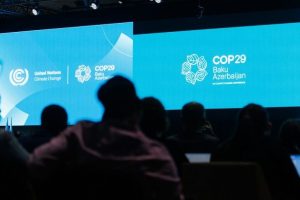For years, the concept of climate justice has been built on the understanding that countries and communities contributing the least to global warming are disproportionately bearing the impacts of climate change.
For example, developing countries have been more affected by climate events due to their existing vulnerabilities and limited capacities to respond – eight out of the top ten countries most affected by climate extreme events from 2000 to 2019 were developing countries, where six were located in Asia.
Based on the principle of equity, climate justice was embedded in the UN Climate Convention in 1992 through principles of “polluter pays” and “common but differentiated responsibilities and respective capabilities”, placing responsibilities to combat climate change on the richer nations.
However, the lack of effective mechanism to operationalize these principles remains an issue to this day. Discussion on “loss and damage” was revived in COP27 in reaction to the failure of developed countries to fulfill their pledge to climate financing to help vulnerable states with climate actions.
While there is currently no clear definition for “loss and damage”, the term essentially refers to the much-contested obligations of countries that have historically benefited from fossil fuel investment to pay for the residual consequences and permanent damage caused by climate change to nature and human societies, predominantly in the developing countries.
Loss and damage encompass both economic and non-economic losses. While economic losses cover damage to resources, physical assets and services; tangible or intangible non-economic losses hold a larger share of the loss and damage, including the impact on individuals (loss of life and health, mobility), societies (loss of cultural heritage, identity, indigenous knowledge), and environment (loss of biodiversity and ecosystem services).
Climate justice and the right to health
Health is the most essential asset of human beings. However, population health, particularly of poor communities in developing countries, is increasingly threatened by the environmental and social changes brought by climate change. This brings in a different outlook on climate justice through the human rights lens.
As health is underpinned by various social and environmental determinants, such as air, water, food, housing and development, the impacts of climate change on those determinants are infringing the fundamental human right to health.
While the Constitution of the World Health Organization (WHO) in 1946 emphasizes the entitlements to equal opportunities to enjoy the “highest attainable standard of health” without discrimination to “race, religion, political belief, economic or social condition”, climate change is exacerbating the existing health inequity and vulnerabilities across the structural social hierarchies, making the progressive realization of the highest attainable standard of health increasingly difficult. This is particularly true among the traditionally discriminated and marginalized communities.
For example, while climate change affects everyone, the health of Indigenous communities is especially vulnerable to climate change due to their close relationships with nature (many Indigenous peoples still rely directly on nature for their basic necessities) and their social and economic marginalization.
In addition, there is emerging evidence showing mental distress among indigenous communities due to the threats upon their culture, identity and sovereignty as they lose or are forced to migrate from their traditional territories due to environmental changes.
Along the same lines, while men and women are affected differently by climate change, women face greater health risks and vulnerabilities due to their particular health needs (e.g. in maternal and reproductive health), household and caregiver roles (e.g. water and food preparation), and underlying gender gaps in access to supports such as resources and critical information that affect their capacity to respond effectively to climate variability, especially in rural and remote areas.
Children and the elderly are also disproportionately affected by the direct and indirect impacts of climate variability on temperature, air quality and food sources due to their unique physiology.
Marginalized groups such as indigenous people and women have often been excluded in decision-making processes concerning climate actions that could affect their health and well-being. Nonetheless, they could be important agents of change while promoting health equity in climate mitigation and adaptation.
For instance, indigenous knowledge on sustainable management and conservation of the environment is a valuable resource. While gender equity in climate actions are increasingly recognized and incorporated in climate finance, youths are at the forefront of climate advocacy fighting for the intergenerational rights to their future well-being.
Climate litigation – a way forward?
On this front, various efforts have been made to call for the acceleration of climate actions around the world. In the past years, advocacy campaigns, strikes, public demonstrations, and activists’ protests have been increasingly reported across media platforms, lobbying for countries to fulfill their climate pledges. Although some progress has been made, they are not enough to catch up with the fast-rising global temperature.
Increasingly individuals and non-governmental organizations are turning to climate litigation as part of the social movements, using human rights law as a strategic instrument to enforce climate actions.
Since the Paris Agreement in 2015, the number of climate change-related lawsuits has doubled from just over 800 cases (1986 -2014) to over 1,200 cases (2015 – 2022), with most cases based in the Global North (particularly in the US) and a growing number of cases from the Global South.
Human rights law offers strong grounds for litigation against states as states hold the primary responsibility and duty to protect human rights. At the European Court of Human Rights, three climate cases are pending before the Grand Chamber of the Court.
Among others, the climate cases were made on the grounds of the human rights violations of the right to life (Article 2), and the right to respect for private and family life (Article 8) as enshrined in the European Convention of Human Rights.
Across Southeast Asia, increasing number of environmental conflicts leading to lawsuits have been documented, prominently in countries like Thailand, Indonesia and the Philippines. Plaintiffs were often communities, non-governmental organizations and civil societies, with cases grounded on state governments’ failure to fulfill treaty obligations (Paris Agreement) and reduce carbon emissions; and corporations’ environmental destructive activities such as illegal logging and peatland burning that violate the human rights to life and healthy environment.
At the local level, government agencies have been sued over their failure to perform duties in ensuring environmental and social protections through governance mechanisms, such as the lack of transparency of environmental impact assessments for project development and inadequacy of environmental standards (e.g. air pollution standards) in protecting citizens’ health.
However, there remain issues of enforcement and jurisdictional limits within the international politics to be dealt with in climate litigations. Besides, lawsuits against governments could be counter-productive if states have limited capacity to respond. Nonetheless, a court proceeding is a catalyst to bring up the longtime debate on climate justice and enforce actions among those held accountable.
Interestingly, a recent study found that these litigation processes are posing financial risks to the polluting carbon majors companies as their market share prices fell after lawsuits.
In addition, the recent advancements on the recognition of human rights in the context of climate change look promising. In June 2022, the UN General Assembly passed a resolution recognizing the human right to a clean, healthy and sustainable environment, and in March 2023, another UN resolution, led by Vanuatu, was passed to secure a legal opinion from the International Court of Justice (ICJ) on states’ accountability and consequences for inaction in the first attempt to establish climate action obligations under international law.
As the establishment of international legal rules are influential on judges and governments, it is hopeful that these efforts will build the momentum in countries’ commitments to climate actions in all member states. The role of civil societies as climate watchdogs remains fundamental in ensuring effective actions are followed through in the quest for climate justice.
Kwan Soo-Chen is a Postdoctoral Fellow and David McCoy is a Research Lead at the United Nations University International Institute for Global Health (UNU-IIGH)
BY KWAN SOO-CHEN AND
DAVID MCCOY
The Ethiopian Herald July 27/2023





